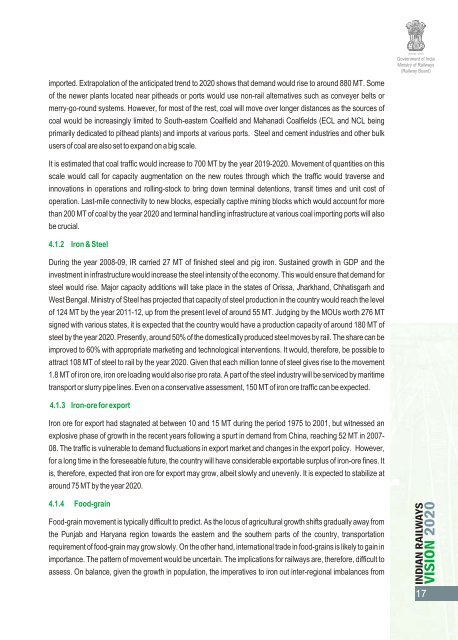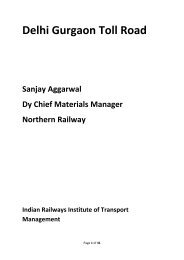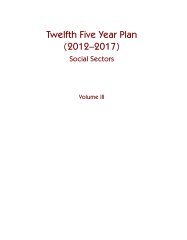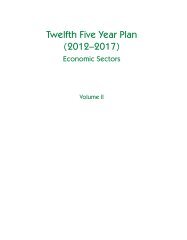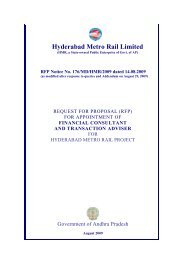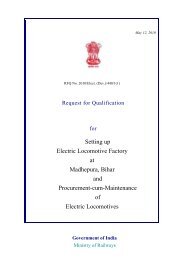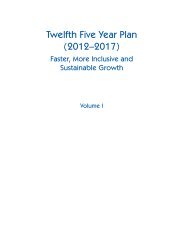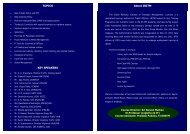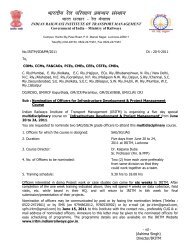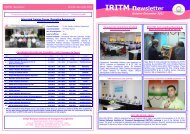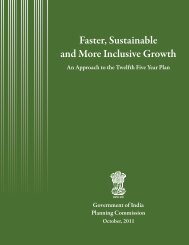Vision 2020 - Transportation Research Group of India
Vision 2020 - Transportation Research Group of India
Vision 2020 - Transportation Research Group of India
Create successful ePaper yourself
Turn your PDF publications into a flip-book with our unique Google optimized e-Paper software.
Government <strong>of</strong> <strong>India</strong><br />
Ministry <strong>of</strong> Railways<br />
(Railway Board)<br />
imported. Extrapolation <strong>of</strong> the anticipated trend to <strong>2020</strong> shows that demand would rise to around 880 MT. Some<br />
<strong>of</strong> the newer plants located near pitheads or ports would use non-rail alternatives such as conveyer belts or<br />
merry-go-round systems. However, for most <strong>of</strong> the rest, coal will move over longer distances as the sources <strong>of</strong><br />
coal would be increasingly limited to South-eastern Coalfield and Mahanadi Coalfields (ECL and NCL being<br />
primarily dedicated to pithead plants) and imports at various ports. Steel and cement industries and other bulk<br />
users <strong>of</strong> coal are also set to expand on a big scale.<br />
It is estimated that coal traffic would increase to 700 MT by the year 2019-<strong>2020</strong>. Movement <strong>of</strong> quantities on this<br />
scale would call for capacity augmentation on the new routes through which the traffic would traverse and<br />
innovations in operations and rolling-stock to bring down terminal detentions, transit times and unit cost <strong>of</strong><br />
operation. Last-mile connectivity to new blocks, especially captive mining blocks which would account for more<br />
than 200 MT <strong>of</strong> coal by the year <strong>2020</strong> and terminal handling infrastructure at various coal importing ports will also<br />
be crucial.<br />
4.1.2 Iron & Steel<br />
During the year 2008-09, IR carried 27 MT <strong>of</strong> finished steel and pig iron. Sustained growth in GDP and the<br />
investment in infrastructure would increase the steel intensity <strong>of</strong> the economy. This would ensure that demand for<br />
steel would rise. Major capacity additions will take place in the states <strong>of</strong> Orissa, Jharkhand, Chhatisgarh and<br />
West Bengal. Ministry <strong>of</strong> Steel has projected that capacity <strong>of</strong> steel production in the country would reach the level<br />
<strong>of</strong> 124 MT by the year 2011-12, up from the present level <strong>of</strong> around 55 MT. Judging by the MOUs worth 276 MT<br />
signed with various states, it is expected that the country would have a production capacity <strong>of</strong> around 180 MT <strong>of</strong><br />
steel by the year <strong>2020</strong>. Presently, around 50% <strong>of</strong> the domestically produced steel moves by rail. The share can be<br />
improved to 60% with appropriate marketing and technological interventions. It would, therefore, be possible to<br />
attract 108 MT <strong>of</strong> steel to rail by the year <strong>2020</strong>. Given that each million tonne <strong>of</strong> steel gives rise to the movement<br />
1.8 MT <strong>of</strong> iron ore, iron ore loading would also rise pro rata. A part <strong>of</strong> the steel industry will be serviced by maritime<br />
transport or slurry pipe lines. Even on a conservative assessment, 150 MT <strong>of</strong> iron ore traffic can be expected.<br />
4.1.3 Iron-ore for export<br />
Iron ore for export had stagnated at between 10 and 15 MT during the period 1975 to 2001, but witnessed an<br />
explosive phase <strong>of</strong> growth in the recent years following a spurt in demand from China, reaching 52 MT in 2007-<br />
08. The traffic is vulnerable to demand fluctuations in export market and changes in the export policy. However,<br />
for a long time in the foreseeable future, the country will have considerable exportable surplus <strong>of</strong> iron-ore fines. It<br />
is, therefore, expected that iron ore for export may grow, albeit slowly and unevenly. It is expected to stabilize at<br />
around 75 MT by the year <strong>2020</strong>.<br />
4.1.4 Food-grain<br />
Food-grain movement is typically difficult to predict. As the locus <strong>of</strong> agricultural growth shifts gradually away from<br />
the Punjab and Haryana region towards the eastern and the southern parts <strong>of</strong> the country, transportation<br />
requirement <strong>of</strong> food-grain may grow slowly. On the other hand, international trade in food-grains is likely to gain in<br />
importance. The pattern <strong>of</strong> movement would be uncertain. The implications for railways are, therefore, difficult to<br />
assess. On balance, given the growth in population, the imperatives to iron out inter-regional imbalances from<br />
17


